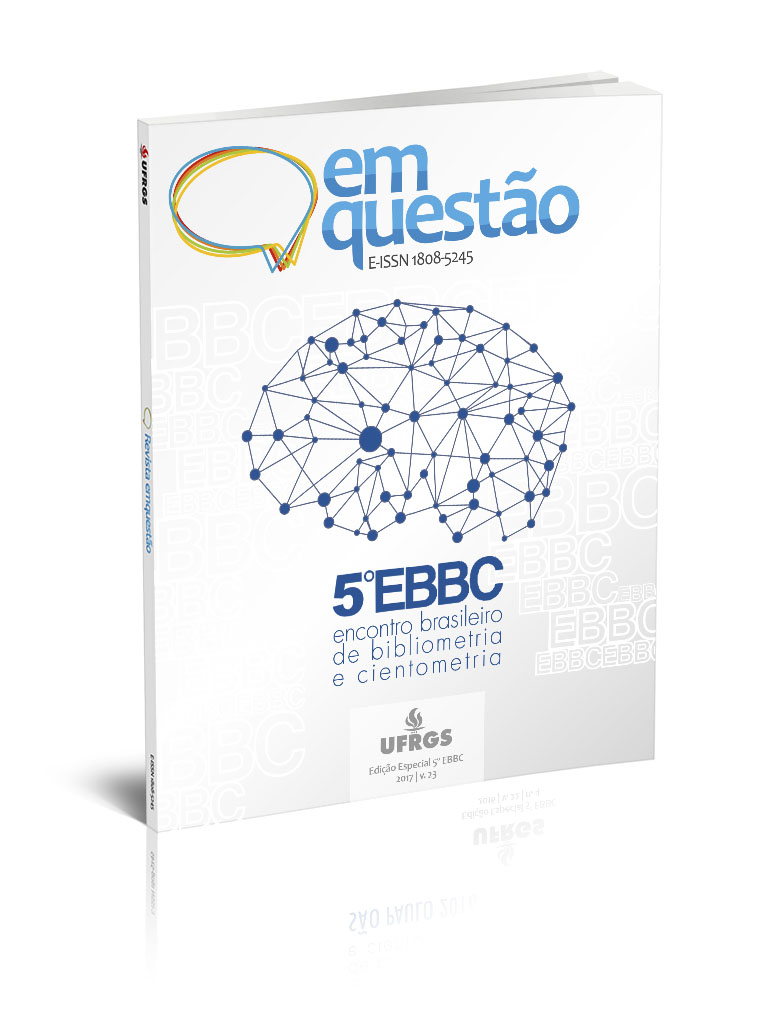Salton's Cosine, Jaccard Index and Pearson's Correlation: comparing normalized and absolute indexed in author co-citation analysis
DOI:
https://doi.org/10.19132/1808-5245230.235-253Keywords:
Normalized Co-citation indicators. Salton’s Cosine. Jaccard index. Pearson’s correlation.Abstract
This research aims to conduct a comparative study between the absolute and normalized indicators for Author Co-citation Analysis, namely: Salton’s Cosine (Sc), Jaccard Index (JI) and Pearson’s correlation (r). As data source, we used the articles from the journal Scientometrics on Scopus database in the subject Metric Studies. We retrieved 234 articles in the 2013-2014 period, in June 2015. We identified 9,327 cited researchers. We generated the absolute matrix with the most co-cited authors, and proceeded to normalizations, through the three processes. In order to compare the results of the absolute matrix with their respective normalized indexes — Salton’s Cosine (Sc), Jaccard Index (JI) and Pearson’s correlation (r) — we calculated Spearman’s correlation. We present the scatter plots and concluded that Salton’s Cosine is preferred, from the research objectives, the nature of the data and greater significance in relation to Spearman’s correlation.Downloads
References
AHLGREN, P. et al. Requirements for a Cocitation Similarity Measure, with Special Reference to Pearson’s Correlation Coefficient. Journal of the American Society for Information Science and Technology, North Carolina, v. 54, n. 6, p. 550-560, 2003.
BENSMAN, S. J. Person’s r and author cocitation analysis: a commentary on the controversy. Journal of the American Society of Information Science & Technology, North Carolina, v. 55, n. 10, p. 935-936, 2004.
COORDENAÇÃO DE APERFEIÇOAMENTO DE PESSOAL DE NÍVEL SUPERIOR. Tabelas de áreas do conhecimento. [Brasília, 2012.] Disponível em:<http://www.capes.gov.br/images/stories/download/avaliacao/TabelaAreasConhecimento_072012.pdf>. Acesso em: 30 ago. 2016.
EGGHE, L.; LEYDESDORFF, L. The relation between Pearson’s correlation coefficient r and Salton’s cosine measure. Journal of the American Society for Information Science and Techology, North Carolina, v. 60, n. 5, p. 1027-1036, 2009.
GLÄNZEL, W. Bibliometrics as a research field: a course on theory and application of bibliometric indicators. Bélgica: [s.n.], 2003. Disponível em:
<http://citeseerx.ist.psu.edu/viewdoc/download?doi=10.1.1.97.5311&rep=rep1&type=pdf>. Last Accessed: 30 August. 2016.
GLÄNZEL, W. et al. Subfield-specific normalized relative indicators and a new generation of relational charts: methodological foundations illustrated on the assessment of institutional research performance. Scientometrics, Dordrecht, v. 78, n. 1, p. 165-188, 2009.
GMÜR, M. Co-citation analysis and the search for invisible colleges: a methodological evaluation. Scientometrics, Dordrecht, v. 57, n. 1, p. 27-57, 2003.
HAMERS, L. et al. Similarity measures in scientometric research: the Jaccard Index versus Salton´s Cosine formula. Information Processing & Management, Elmsford, v. 25, n. 3, p. 315-318, 1989.
HJØRLAND, B. Domain analysis in information science: eleven approaches traditional as well as innovative. Journal of Documentation, London, v. 58, n. 4, p. 422-462, 2002.
LEYDESDORFF, L.; VAUGHAN, L. Co-occurrence Matrices and their applications in Information Scien¬ce: Extending ACA to the Web environment. Journal of the American Society for Information Science and Technology, North Carolina, v. 57, n. 12, p. 1616-1628, 2006.
LIBERATORE, G.; HERRERO-SOLANA, V.; GUIMARAES, J. A. C. Análise
bibliometrica do periódico brasileiro Ciência da Informação durante o período 2000-2004. Brazilian Journal of Information Science, Marília, v. 1, n. 2, p. 3-21, 2007.
LUUKKONEN, T. et al. The measurement of international scientific collaboration. Scientometrics, Dordrecht, v. 28, n. 1, p. 15-36, 1993.
MOYA ANEGÓN, F.; JIMÉNEZ CONTRERAS, E.; MONEDA CORROCHANO, M. Research fronts in library and information science in Spain (1985-1994). Scientometrics, Dordrecht, v. 42, n. 2, p. 229-246, 1998.
PINHEIRO, L. V. R.; SILVA, G. S. Cartografia histórica e conceitual da
bibliometria/informetria no Brasil. In: CONFERÊNCIA IBERO-AMERICANA DE PUBLICAÇÕES ELETRÔNICAS NO CONTEXTO DA COMUNICAÇÃO CIENTÍFICA (CIPECC), 2., 2008, Rio de Janeiro. Sub-Tema 2–Metrias da comunicação científica: da bibliometria/informetria à Webmetria. Anais eletrônicos...Rio de Janeiro: [s.n.], 2008. Disponível em: <http://ridi.ibict.br/handle/123456789/67>.Acesso em: 30 ago. 2016.
SMALL, H. Co-citation in the scientific literature: a new measure of the relationship between two documents. Journal of the American Society for Information Science, North Carolina, v. 24, n. 4, p. 265-269, 1973.
SMIRAGLIA, R. P. Domain coherence within Knowledge Organization: people, interacting theoretically, across geopolitical and cultural boundaries. In: ANNUAL CAIS/ACSI CONFERENCE, 39, June 2-4, 2011, Canada. Proceedings... Canada: University of New Brunswick, 2011. p. 1-6. Disponível em:<https://journals.library.ualberta.ca/ojs.cais-acsi.ca/index.php/cais-asci/article/view/601/551>. Acesso em: 30 ago. 2016.
VANZ, S. A. S. As redes de colaboração no Brasil (2004-2006). 2009. 204 f. Tese (Doutorado em Comunicação e Informação) – Faculdade de Biblioteconomia e Comunicação, Universidade Federal do Rio Grande do Sul, Porto Alegre, 2009.
WHITE, H. D. Author cocitacion analysis and Pearson’s r. Journal of the American Society of Information Science and Technology, North Carolina, v.54, n.13, p. 1250-1259, 2003.
WHITE, H. D.; GRIFFITH, B. Author co-citation: a literature measure of intellectual structure. Journal of the American Society for Information Science and Technology, North Carolina, v. 32, n. 2, p. 163-171, 1981.
WHITE, H.D.; MCCAIN, K.W. Visualizing a discipline: an author co-citation analysis of Information Science, 1972-1995. Journal of the American Society for Information Science and Technology, North Carolina, v. 49, n. 4, p. 327-355, 1998.
Downloads
Published
How to Cite
Issue
Section
License
Copyright (c) 2017 Em Questão

This work is licensed under a Creative Commons Attribution 4.0 International License.
Authors who publish with this journal agree to the following terms:
Authors will keep their copyright and grant the journal with the right of first publication, the work licensed under License Creative Commons Attribution (CC BY 4.0), which allows for the sharing of work and the recognition of authorship.
Authors can take on additional contracts separately for non-exclusive distribution of the version of the work published in this journal, such as publishing in an institutional repository, acknowledging its initial publication in this journal.
The articles are open access and free. In accordance with the license, you must give appropriate credit, provide a link to the license, and indicate if changes were made. You may not apply legal terms or technological measures that legally restrict others from doing anything the license permits.













